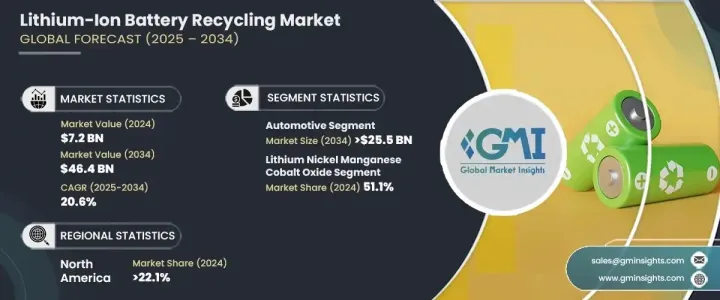
세계의 리튬 이온 배터리 재활용 시장은 2024년 72억 달러로 평가되었으며, 2025년부터 2034년까지 연평균 성장률(CAGR)은 20.6%를 보일 것으로 예측됩니다.
특히 전기자동차(EV)와 재생 에너지 저장장치 등 산업 전반에서 리튬 이온 배터리 사용이 급증하면서 부적절한 폐기와 환경 위험에 대한 우려가 증폭되고 있습니다. 이러한 배터리에는 리튬, 코발트, 니켈, 망간과 같이 귀중하지만 잠재적으로 독성이 있는 물질이 포함되어 있기 때문에 효율적인 재활용은 선택이 아닌 필수가 되었습니다. 지속 가능성과 순환 경제를 향한 전 세계적인 노력은 중요한 물질을 회수하고 생태계에 미치는 영향을 최소화하며 환경에 해로운 채굴 활동에 대한 의존도를 줄이기 위한 강력한 재활용 시스템 구축의 중요성을 더욱 강조하고 있습니다.

전 세계 정부와 규제 기관은 환경 정책을 강화하면서 제조업체가 배터리 재활용에 우선순위를 두도록 강요하고 있습니다. 리튬 이온 배터리 재활용에 대한 수요는 산업이 점점 더 전기화로 전환함에 따라 가속화되고 있으며, 이로 인해 필수 원자재 공급에 상당한 부담이 되고 있습니다. 특히 자동차 산업은 전기차 제조업체들이 배터리 생산에 필요한 원료를 확보하기 위해 지속 가능한 대안을 모색하면서 이러한 성장을 주도하는 중추적인 역할을 하고 있습니다. 운송, 에너지 저장 및 소비자 가전 분야에서 리튬 이온 배터리에 대한 수요가 급증하는 상황에서 효과적인 재활용 솔루션이 없다면 공급망은 잠재적인 혼란에 직면할 수 있습니다. 탄소 배출량 감축에 대한 강조가 높아지면서 재료 회수율을 높이고 환경에 미치는 영향을 최소화하는 첨단 재활용 기술에 대한 투자도 활발해졌습니다.
| 시장 범위 | |
|---|---|
| 시작 연도 | 2024년 |
| 예측 연도 | 2025-2034년 |
| 시작 금액 | 72억 달러 |
| 예측 금액 | 464억 달러 |
| CAGR | 20.6% |
자동차 부문은 2034년까지 255억 달러에 달할 것으로 예측됩니다. 전기차의 급속한 보급으로 배터리 재활용에 대한 필요성이 대두되면서 귀중한 자재를 효율적으로 재사용할 수 있는 방안이 절실히 요구되고 있습니다. 북미, 유럽, 아시아태평양 지역의 규제 의무로 인해 자동차 제조업체는 지속 가능한 배터리 폐기 관행을 구현해야 하며, 이는 시장 확대를 더욱 촉진하고 있습니다. 더욱 엄격한 정책이 시행됨에 따라 업계 리더들은 회수율을 극대화하고 처리 비용을 절감하는 최첨단 재활용 기술에 투자하고 있습니다.
시장은 배터리 화학에 따라 세분화되며(2024년)에는 리튬 니켈 망간 코발트 산화물이 51.1%의 점유율을 차지할 것으로 예상됩니다. NMC 배터리는 높은 에너지 밀도와 긴 사이클 수명으로 인해 전기차 및 에너지 저장 시스템에 널리 사용됩니다. 이 배터리의 구성은 특히 재활용 가치가 높으며, 회수된 물질은 채굴에 대한 비용 효율적이고 친환경적인 대안을 제공하기 때문에 재활용에 특히 유용합니다. 고성능 에너지 저장 솔루션에 대한 수요가 증가함에 따라 NMC 배터리의 재활용은 상당한 발전을 이룰 것으로 예상됩니다.
미국의 리튬 이온 배터리 재활용 시장은 2024년에 9억 달러 규모로 평가되었으며, 점점 더 엄격해지는 환경 규제가 시장 확대를 주도하고 있습니다. 자동차 및 전자 산업 전반의 기업들은 지속 가능성을 운영에 통합하고, 배터리 재활용 노력을 구현하여 폐기물을 최소화하고 중요한 자재를 회수하고 있습니다. 전기차 및 재생 에너지 저장 솔루션에 대한 수요가 증가함에 따라 미국 시장은 배터리 재활용에 대한 규제 인센티브와 기술 혁신에 힘입어 크게 성장할 것으로 전망됩니다.
The Global Lithium-Ion Battery Recycling Market was valued at USD 7.2 billion in 2024 and is projected to grow at a CAGR of 20.6% between 2025 and 2034. The surge in lithium-ion battery usage across industries, particularly in electric vehicles (EVs) and renewable energy storage, has amplified concerns regarding improper disposal and environmental hazards. As these batteries contain valuable but potentially toxic materials like lithium, cobalt, nickel, and manganese, their efficient recycling has become a necessity rather than an option. The global push toward sustainability and the circular economy further underscores the importance of establishing robust recycling systems to recover critical materials, minimize ecological impact, and reduce dependency on environmentally damaging mining activities.

Governments and regulatory bodies worldwide are tightening environmental policies, compelling manufacturers to prioritize battery recycling. The demand for lithium-ion battery recycling is accelerating as industries increasingly shift toward electrification, leading to a significant strain on the supply of essential raw materials. The automotive industry, in particular, plays a pivotal role in driving this growth as EV manufacturers seek sustainable alternatives to secure materials for battery production. Without effective recycling solutions, the supply chain faces potential disruptions, given the soaring demand for lithium-ion batteries in transportation, energy storage, and consumer electronics. The rising emphasis on reducing carbon emissions has also spurred investment in advanced recycling technologies that enhance material recovery rates and minimize environmental impact.
| Market Scope | |
|---|---|
| Start Year | 2024 |
| Forecast Year | 2025-2034 |
| Start Value | $7.2 Billion |
| Forecast Value | $46.4 Billion |
| CAGR | 20.6% |
The automotive sector is expected to be a major contributor to the market, with projections estimating USD 25.5 billion by 2034. The rapid adoption of EVs has created a pressing need for battery recycling, ensuring the efficient reuse of valuable materials. Regulatory mandates across North America, Europe, and Asia-Pacific are compelling automakers to implement sustainable battery disposal practices, further fueling market expansion. With stricter policies in place, industry leaders are investing in cutting-edge recycling technologies that maximize recovery rates and reduce processing costs.
The market is segmented by battery chemistry, with lithium nickel manganese cobalt oxide holding 51.1% share in 2024. NMC batteries are widely used in EVs and energy storage systems due to their high energy density and long cycle life. Their composition makes them particularly valuable for recycling, as the recovered materials offer a cost-effective and eco-friendly alternative to mining. As demand for high-performance energy storage solutions grows, the recycling of NMC batteries is expected to witness substantial advancements.
The U.S. Lithium-Ion Battery Recycling Market was valued at USD 900 million in 2024, with increasingly stringent environmental regulations driving its expansion. Businesses across the automotive and electronics industries are integrating sustainability into their operations, implementing battery recycling initiatives to minimize waste and recover critical materials. As the demand for EVs and renewable energy storage solutions rises, the U.S. market is poised for significant growth, fueled by regulatory incentives and technological innovations in battery recycling.